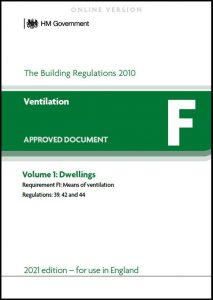Changes to the Building Regulations and Technical Standards in England, Wales and Scotland
Revisions to Part F of the Building Regulations for Wales, will come into force in November later this year, and the domestic Building Standards Technical Handbook in Scotland have also been consulted on. A detailed review of ventilation regulations in Northern Ireland is also due to take place in 2022.
This is all part of the Government’s proposals for the Future Homes Standard, which provides a pathway for highly efficient buildings that are zero carbon ready, better for the environments and fit for the future. Implementation of a full technical specification is scheduled for 2025.
Below is Titon’s summary of the main points. Please ensure you read the full documents for full implications
The web page below is available as a downloadable PDF, please click link for a copy. 2022 Ventilation Regulations Update
Updated ADF CPD now available

 Following the update to the Building Regulations 2010 (Part F1 Dwellings 2022), Titon has revised its popular ‘Part F 2010 Domestic Buildings Compliance’ CPD presentation to help gain a deeper understanding of the new requirements.
Following the update to the Building Regulations 2010 (Part F1 Dwellings 2022), Titon has revised its popular ‘Part F 2010 Domestic Buildings Compliance’ CPD presentation to help gain a deeper understanding of the new requirements.
Should you wish to register interest, please click on the link following link – CPD Registration
England - Revised Approved Document F publication issued December 2021 with effective date 15th June 2022
What are the changes for background ventilators (e.g. trickle vents in windows or doors)? |
||
| NOTE: All sizes shown are minimum sizes. | ||
| New Homes – using Natural ventilation with background ventilators and intermittent extract fans guidance suitable only for less air tight dwellings): (Formerly System 1 – Intermittent extract fans and background ventilators) |
||
| 2010 Regulation Guidance | 2022 Regulation Guidance | |
| Ventilation amounts, and therefore number of trickle vents required, vary according to a number of criteria including room type, occupancy levels based on bedroom types, floor area of property. These can range from 35,000mm2EA to over 65,000mm2EA. | These are now simpler per room amounts;
There are some sub-rules:
|
|
| NOTE: The guidance for natural ventilation is only suitable for less airtight dwellings. For the design, sizing and positioning of ventilators to provide effective ventilation using natural ventilation for highly-airtight dwellings expert advice should be sought. | ||
| New Homes using continuous extract ventilation systems: (Formerly System 3 – Continuous mechanical extract and (MEV)) |
|
| 2010 Regulation Guidance | 2022 Regulation Guidance |
| Trickle vents should provide 2,500mm2EA in each habitable room | Trickle vents should provide 4,000mm2EA in each habitable room |
| NOTE: The guidance for mechanical extract ventilation is suitable for highly-airtight dwellings only. For the design, sizing and positioning of ventilators to provide effective ventilation using mechanical extract for less airtight dwellings expert advice should be sought. | |
| New Homes using mechanical ventilation with heat recovery systems: (Formerly System 4 – Continuous mechanical supply and extract with heat recovery (MVHR)) |
|
| 2010 Regulation Guidance | 2022 Regulation Guidance |
| No change, trickle ventilators are not required because these are balanced ventilation systems in more energy efficient house designs | No change, trickle ventilators are not required because these are balanced ventilation systems in more energy efficient house designs |
| NOTE: The guidance for mechanical supply and extract ventilation is suitable for any level of airtightness. | |
| Existing Homes: | |
| 2010 Regulation Guidance | 2022 Regulation Guidance |
|
In all cases there is now an Installation & Commissioning Checklist that needs to be completed and handed over by the installer, this includes background ventilation sign off. This Checklist appears in the Approved Document ‘Part’ F, as opposed to the separate DVCG (Domestic Ventilation Compliance Guide) which has been made obsolete. |
Documentation for Homes: |
||
| 2010 Regulation Guidance | 2022 Regulation Guidance | |
| Domestic Ventilation Compliance Guide (now obsolete). | Home User Guide for new dwellings (4.18 & 4.19)
Additional information for work in existing dwellings (4.20)
Go to – https://www.gov.uk/government/publications/home-user-guide-template for the Home Energy Guide Template and the Existing Home Ventilation Guide. |
|
| NOTE: Information about overheating and the conservation of fuel and power are required under different regulations and guidance is given in Approved Documents O (Overheating) and L (Conservation of fuel and power). Where the system provides more than one function, the owner should be informed of each separate function. | ||
Operating and maintenance instructions (4.13, 4.14 & 4.15)
|
||
What are the changes for Mechanical Ventilation?
| 2010 Regulation Guidance | 2022 Regulation Guidance |
| System 1: Background ventilators and intermittent extract fans. |
Natural ventilation with background ventilators and intermittent extract fans (guidance suitable only for less airtight dwellings)
Dwellings covered by the guidance – Less Airtight Dwellings |
| System 3: Continuous mechanical extract (MEV) |
Continuous mechanical extract ventilation
Dwellings covered by the guidance – All Dwellings |
| System 4: Continuous mechanical supply and extract with heat recovery (MVHR) |
Mechanical ventilation with heat recovery
Dwellings covered by the guidance – All Dwellings |
| All systems | Highly airtight dwellings:
Dwellings that achieve one of the following. a. A design air permeability lower than 5m3/(h·m2) at 50Pa. Where the guidance for highly airtight dwellings is followed, dwellings are assumed to have an infiltration rate of 0 air changes per hour. Airtightness level must be proved if no trickle vents are to be fitted into a ‘Less airtight dwelling’. Less airtight dwellings: Those dwellings that are not highly airtight dwellings. Where the guidance for less airtight dwellings is followed, dwellings are assumed to have an infiltration rate of 0.15 air changes per hour. |
| 2010 Regulation Guidance | 2022 Regulation Guidance | ||||||||||
| Table 5.1b – Whole dwelling ventilation rates | Minimum whole dwelling ventilation rates | Table 1.3 – Minimum whole dwelling ventilation rates | Whole dwelling ventilation rates | ||||||||
| Number of bedrooms | 1 | 2 | 3 | 4 | 5 | Number of bedrooms | 1 | 2 | 3 | 4 | 5 |
| Whole dwelling ventilation rate (a.b.) l/s |
13 | 17 | 21 | 25 | 29 | Minimum ventilation rate criterion 1 – by number of bedrooms |
19 | 25 | 31 | 37 | 43 |
| Minimum ventilation rate criterion 2 – by floor area |
0.3 l/s per m2 of internal floor area | ||||||||||
| Notes:
a. In addition, the minimum ventilation rate should be not less than 0.3 l/s per m2 of internal floor area. (This includes all floors, e.g. for a two-storey building add the ground and first floor areas.) b. This is based on two occupants in the main bedroom and a single occupant in all other bedrooms. This should be used as the default value. If a greater level of occupancy is expected add 4 l/s per occupant. |
A minimum rate of 0.3 litres per second per m2 of internal floor area (this includes all floors, e.g. for a two-storey building, add the ground-floor and first-floor areas).
Notes: 1. Where the dwelling has only one habitable room, a minimum ventilation rate of 13 litres per second should be used. 2. For each additional bedroom, add 6 litres per second to the values in Table 1.3 |
||||||||||
Example of change:
Minimum whole dwelling rate [continuous rate]
Large increase in per bedroom rate could equate to a higher whole house continuous rates. Example below looking at 70m2 .
| 2010 Regulation Guidance | 2022 Regulation Guidance |
|
|
| Noise | |
| 2010 Regulation Guidance | 2022 Regulation Guidance |
| 1.5 – Mechanical ventilation systems, including both continuous and intermittent mechanical ventilation should be designed and installed to minimise noise.
This includes all of the following:
1.6 – For mechanical ventilation systems, fan units should 1.7 – Account should be taken of outside noise when |
|

